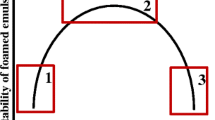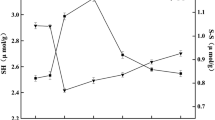Abstract
A droplet fractionation method was previously developed to concentrate a dilute nonfoaming protein solution. In that earlier study with invertase, it was demonstrated that droplets created by ultrasonic energy waves could be enriched up to 8 times that of the initial dilute invertase solution. In this study, a mixture of bromelain (a foaming protein) and invertase (a nonfoaming protein) is investigated as a preliminary step to determine if droplet fractionation can also be used to separate a non-foaming protein from foaming proteins. The foaming mixture containing bromelain is first removed by bubbling the binary mixture with air. After the foam is removed, the protein rich air-water interfacial layer is skimmed off (prior to droplet fractionation) so as not to interfere with the subsequent droplet production from the remaining bulk liquid, rich in non-foaming protein. Finally, sonic energy waves are then applied to this residual bulk liquid to recover droplets containing the non-foaming protein, presumed to be invertase. The primary control variable used in this droplet fractionation process is the pH, which ranged for separate experiments between 2 and 9. It was observed that the maximum overall protein partition coefficients of 5 and 4 were achieved at pH 2 and 4, respectively, for the initial foaming experiment followed by the post foaming droplet fractionation experiment.
Similar content being viewed by others
References
Karger, B. L., L. R. Snyder, and C. Horvath (1973)An Introduction to Separation Science, pp. 424–432, John Wiley & Sons, New York, NY, USA.
Ko, S., V. Loha, L. Du, A. Prokop, and R. D. Tanner (1999) Partitioning invertase between a dilute water solution and generated droplets.Appl. Biochem. Biotechnol. 77: 501–510.
Macrae, R., R. K. Robinson, and M. J. Sadler (1999)Encyclopedia of Food Science Food Technology and Nutrition, Vol. 6: p. 3603 Academic Press, New York, NY, USA.
Bradford, M. M. (1976) Rapid and sensitive method for quantitation of microgram quantities of protein utilizing principle of protein-dye.Anal. Biochem. 72: 248–264.
Miller, G. L. (1959) Using dinitrosalicylic acid reagent for determination of reducing sugar.Anal. Chem. 31: 426–428.
Kokitkar, P. B. and R. D. Tanner (1991) Determination of the partition of the partition-coefficient for yeast invertase between microwater droplets in air in contact with liquid water.Appl. Biochem. Biotechnol. 28: 647–654.
Author information
Authors and Affiliations
Corresponding author
Rights and permissions
About this article
Cite this article
Ko, S., Prokop, A. & Tanner, R.D. Effect of pH on successive foam and sonic droplet fractionation of a bromelain-invertase mixture. Biotechnol. Bioprocess Eng. 7, 26–30 (2002). https://doi.org/10.1007/BF02935876
Received:
Accepted:
Issue Date:
DOI: https://doi.org/10.1007/BF02935876




